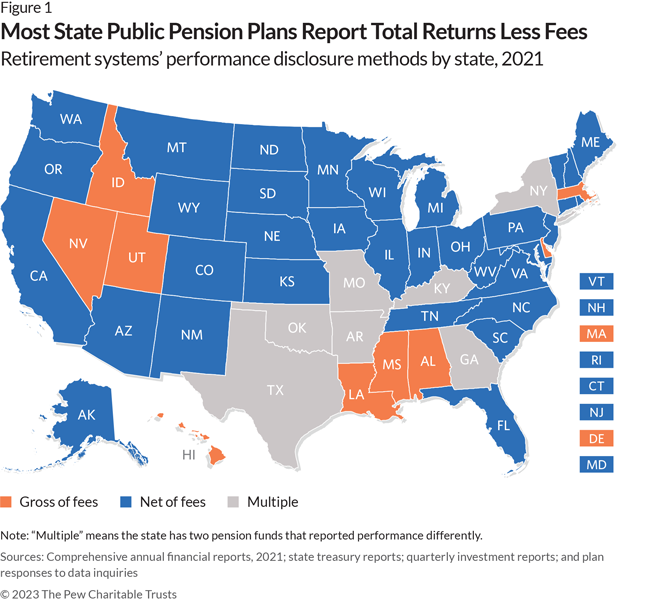Transparency in Investment Disclosures Helps Promote Effective Public Pension Administration
Recent changes hold promise for better management and oversight, but more is needed

Overview
State and local pension funds collectively hold more than $5 trillion in assets to pay for promised benefits to workers and retirees.1 On average, about three-quarters of these assets are allocated to risky investments, including stocks, as well as nontraditional investments such as private equity, real estate, and hedge funds, which collectively are known as “alternatives.” Although these types of investments can yield significant returns and help diversify investment portfolios, they also come with elevated risks and hefty management fees.
Public pension plans’ use of alternative investments has more than doubled over the past 15 years. And with that, total investment fees also have increased, with state funds reporting costs in excess of $10 billion annually. From 2006 to 2019, fees as a share of total investments grew from 0.26% to 0.35%—a 30% increase as a percentage of assets.
To ensure that pension funds make sound investment decisions that are balanced against risk exposure, policymakers, stakeholders, and the public need complete information on investment performance and costs.
However, many plans’ disclosures are not sufficiently transparent, leaving stakeholders without the data they need to accurately assess the performance of investment funds.
In 2016, The Pew Charitable Trusts examined the investment disclosure practices (using 2014 data) of the nation’s 73 largest pension funds, which collectively hold about 95% of state pension assets. That study found that although public retirement systems receive the same guidance on disclosing their investment details— from the Governmental Accounting Standards Board (GASB) and Government Finance Officers Association (GFOA)—they interpret and implement the standards differently. And, as a result, their disclosure practices vary significantly, particularly regarding fees.
That research also identified specific practices plan administrators and boards of trustees should consider to improve the transparency of pension operations and investments. This issue brief updates that study, using publicly available data from those same 73 funds as of 2021, to assess how state pension funds have progressed in adopting three of these practices related to reporting and disclosure. Specifically, this update reviews state fund policy changes related to:
- Making investment policy statements comprehensive, transparent, and readily accessible to stakeholders.
- Disclosing bottom-line performance, not only gross of fees but also net of fees, which reflects the return on investments after subtracting fees paid to investment managers.
- Adopting comprehensive fee-reporting practices for private equity investments, including performance fees.
Overall, this analysis finds that the number of funds following these recommended practices grew from 2016 to 2021, in some cases substantially. These increases can probably be attributed to growing industry and public awareness of the need for transparency in pension investments, including among organizations such as GASB and GFOA, which, along with Pew, have provided some concrete guidelines for reporting in recent years. But the 73 funds still vary widely in their disclosure of investment costs, demonstrating an ongoing need for better, more consistent disclosure rules to help stakeholders discern how well investments are being managed.
Most plans’ investment policy statements are publicly available
The GFOA recommends that each pension plan develop a concrete investment policy that describes its risk and return objectives, as well as the target percentage of its assets to be allocated to each type of investment.2 But setting policies and targets alone is insufficient to effectively promote transparency. By ensuring that these policies are readily accessible to stakeholders online, plan administrators can create a foundation of openness in public pension management—providing trustees, policymakers, and workers with the information they need to understand and assess the strategies that systems follow for the investment of public funds.
Of the 73 plans examined, 64 made their investment policies publicly available online in 2021, up slightly from 59 in 2016.3
Plans can do more to disclose bottom-line performance
To fully understand investment performance, public pension stakeholders need clear information that accounts for the costs of managing assets. Providing net of fees performance is consistent with the Global Investment Performance Standards for Asset Owners established by the CFA Institute.4
Pew found that from 2016 to 2021, plans made progress on transparent fee disclosure. In 2016, more than a third of pension funds (27) reported only their investment performance gross of fees. But by fiscal year 2021, that figure had dropped to about a quarter of funds (18). (See Figure 1.) Although this represents good progress since 2014, many state plans still do not provide the information stakeholders need to accurately assess investment performance.5
Reporting investment returns in both gross- and net-of-fee terms gives stakeholders information on the cost and bottom-line results of pension funds’ investment strategies. Directly comparing net and gross returns is a clear, easy way to view the impact of fees on fund performance.
Increased Use of Alternative Investments Bolsters Calls for More Effective Risk Disclosures
Pension plans’ growing use of alternative investments in recent years and the lack of standardized disclosure practices have spurred a variety of interventions by regulatory and nongovernmental entities to promote greater consistency in reporting:
- GASB in 2020 launched a research project to evaluate whether existing guidance on disclosing investment fees charged by private investment managers is sufficient.6
- More than 180 asset managers and other investment organizations, including some U.S. public pension funds, have endorsed a set of comprehensive fee disclosure practices that the Institutional Limited Partners Association (ILPA), a member organization for private equity managers, introduced in 2016.
- Two private companies serving institutional investors launched the Global Pension Transparency Benchmark (GPTB) in 2021 to provide pension fund managers around the world with a holistic approach to assessing transparency and improving plan outcomes. GPTB evaluated the top five funds in each of 15 countries—75 funds in total—and found a need for substantial improvement in transparency worldwide. The study ranked U.S. public pension funds ninth out of the 15 countries, noting that U.S. funds “did not provide much relevant cost information.”7
Plans have improved their fee reporting
Pew’s 2016 analysis found that whether a plan included or omitted performance fees when calculating investment management costs contributed significantly to the wide variation in reported fees across the 73 funds.8 In private equity investment, the general partner, consisting of investment firms or a group of professionals responsible for managing the fund, typically receives management fees and a share of the fund’s profits, known as carried interest or performance fees, as compensation. The average value of undisclosed private equity fees, including carried interest, can equal 1.5% or more of annual assets, or about half of pension funds’ total private equity management costs.
In 2016, ILPA recommended disclosure of all carried interest and fee expenses, sorted by investment manager. And although such comprehensive disclosure of private equity fees is still uncommon, the number of pension funds making at least a good faith effort has more than doubled since 2014, growing from four to at least 10 in 2021.
Of those 10 pension plans, five stand out for the most robust reporting of fees. The two earliest adopters cited in Pew’s 2016 study, the South Carolina Retirement System and the Missouri State Employees’ Retirement System, have reported performance fees by individual private equity manager or investment fund for nearly a decade.9 More recently, the California Public Employees’ Retirement System, North Carolina Retirement System, and Pennsylvania Public School Employee Retirement Systems have begun comprehensive and routine disclosure of carried interest and profit-sharing fees. 10
In addition, the California State Teachers’ Retirement System and Pennsylvania State Employees Retirement System now report the total carried interest earned by investment managers.11 Although these disclosures, which are included in supplemental fee and expense reports, do not break those earnings down by individual investment manager as recommended by ILPA, they nevertheless represent a significant step toward transparency that most state plans have yet to adopt.
Further, several funds have taken steps toward disclosing aggregated private equity performance fees. For example, the New York State and Local Retirement System calculates private equity fees and expenses, including the total cost of carried interest, based on information provided by external investment managers and consultants, as well as on private equity financial statements.12 Similarly, the Ohio Public Employees Retirement System and the Arizona State Retirement System now report details on net management fees, fund expenses, and performance fees, including a good faith estimate of carried interest by asset class. 13
Conclusion
No one approach to investing is appropriate for all pension plans, but the risk and complexity inherent in the equity and alternative investments that make up most public pension fund assets demand greater transparency in plan reporting. Policymakers, workers, retirees, and taxpayers need full disclosure on investment performance and fees to ensure that risks, returns, and costs are balanced according to established best practices and meet funds’ needs.
Appendix: Data sources
To examine changing investment practices across the 50 states, Pew used three data sources covering the 73 largest state-sponsored pension funds, which managed most of the nearly $4 trillion of assets under management by state-run pension plans in 2021:
- Plans’ comprehensive annual financial reports, actuarial valuations, and other relevant documents published from 1992 to 2021, with a primary focus on asset allocation, performance, and fees from 2006 to 2019.
- The U.S. Federal Reserve Financial Accounts of the United States, which include aggregate economic and investment data on public pensions from 1954 to 2019.
- The Wilshire Trust Universe Comparison Service performance comparisons, reported quarterly from 1981 to 2021.
Together, these data sets provide a 60-year picture of aggregate investment trends and a detailed look at investment practices from 2006 to 2021 across nearly all state public pension funds.
Endnotes
- U.S. Census Bureau, 2021 Annual Survey of Public Pensions: State & Local Tables, https://www.census.gov/data/tables/2021/econ/aspp/aspp-historical-tables.html.
- N. Greifer, A Guide for Establishing a Pension Investment Policy (Chicago: Government Finance Officers Association, 2003).
- The Pew Charitable Trusts, “Making State Pension Investments More Transparent” (2016), https://www.pewtrusts.org/en/research-andanalysis/issue-briefs/2016/02/making-state-pension-investments-more-transparent.
- CFA Institute, “Global Investment Performance Standards (GIPS) Handbook” (2007), https://www.gipsstandards.org/pdfviewer/?file=6954&search=net%20of%20fee.
- State pension funds reporting returns gross of fees as of fiscal 2021 were the Alabama State Retirement System, Alabama Teachers’ Retirement System, Arkansas Public Employees Retirement System, Delaware Public Employees Retirement System, Georgia Employees Retirement System, Hawaii Employees Retirement System, Idaho Public Employee Retirement System, Kentucky Teachers Retirement System, Louisiana State Employees Retirement System, Louisiana Teachers Retirement System, Massachusetts State Employees Retirement System & Teacher Retirement Board, Mississippi Public Employees Retirement System, Nevada Public Employees Retirement System, Oklahoma Public Employees Retirement System, Texas Employees Retirement System, and Utah Retirement Systems.
- Florida Government Finance Officers Association, “GASB Survey on Investment Fees” (2020), https://www.fgfoa.org/docs/defaultsource/e-bulletin/e-bulletin-(old)/fgfoa-e-bulletin---gasb-survey-on-investment-fees.pdf?sfvrsn=131edad5.
- Global Pension Transparency Benchmark, “Global Pension Transparency Benchmark,” accessed March 11, 2022, https://global-pensiontransparency-benchmark.top1000funds.com/.
- The Pew Charitable Trusts, “Making State Pension Investments More Transparent.”
- South Carolina Retirement System Investment Commission, “Annual Investment Report 2020-2021” (2021), https://www.rsic.sc.gov/_documents/annual-investment-reports/2021-annual-report.pdf; Missouri State Employees’ Retirement System, “Chief Investment Officer’s Report” (2021), https://www.mosers.org/docs/default-source/funding/annual-reports/2021-acfr/2021-annual-reportinvestment.pdf?sfvrsn=33f32dd2_13.
- North Carolina Department of State Treasurer, “Investment Policy Statement for North Carolina Retirement Systems” (2020), https://files.nc.gov/nctreasurer/documents/files/IMD/GovernancePoliciesAndGuidelines/investment-policy-statement-for-ncrs.pdf.
- California State Teachers’ Retirement System, “Investment Policies,” accessed July 19, 2023, https://www.calstrs.com/investmentpolicies; Commonwealth of Pennsylvania State Employees’ Retirement System, “SERS’ Defined Benefit Plan Investment Policy Statement” (2021), http://sers.pa.gov/pdf/investments/InvestmentPolicyStatement.pdf.
- New York State and Local Retirement System, “2019 Comprehensive Annual Financial Report” (2019), https://www.osc.state.ny.us/files/retirement/resources/pdf/comprehensive-annual-financial-report-2019.pdf.
- Ohio Public Employees Retirement System, “Ohio Public Employees Retirement System Annual Investment Plan” (2023), https://www.opers.org/investments/inv-plans.shtml; Arizona State Retirement System, “Investment Policy Statement” (2022), https://www.azasrs.gov/sites/default/files/pdf/Investment%20Policy%20Statement%20Feb%202022.pdf.


America’s Overdose Crisis
Sign up for our five-email course explaining the overdose crisis in America, the state of treatment access, and ways to improve care
Sign up














